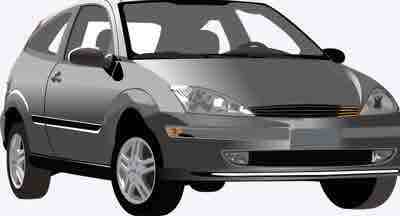Ever thought of replacing your vehicle tires but you seem not to know when exactly? How your tires perform is very important to maintain the efficiency and safety of your vehicle.
But of course, your tires will lose their traction and start wearing out at some point as you can’t keep using them forever.
Having a blowout and bad traction are likely to happen when you have bad tires, so it’s important to be able to detect when your tires are bad and needs to be replaced.
Luckily, this article will help you know when your vehicle needs a new tire with the 10 signs discussed below:
Table of Contents
Bald tires
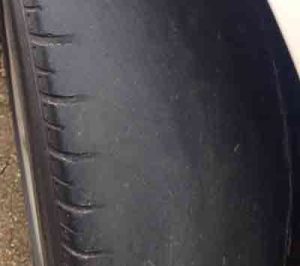
This is one of the obvious signs to note when your tires are due to be replaced. What are bald tires? Simply say that bald tires are tires that have less or no tread left.
It is unsafe to drive on bald tires as this can cause damages to the vehicle either due to tire failures or loss of vehicle control.
For a safe and smooth drive, your tires need more tread that will provide traction, the longer miles you take, it wears down.
Bald tires can be extremely dangerous to drive. When you speed on your bald tires for too long, a little puncture can cause tremendous havoc like accidents on the road. This could be fatal.
Also, when it rains you may lose traction and mainly control of your vehicle. For this reason, bald tires are extremely hazardous to drive on and should be replaced when detected.
Cracked Sidewalls
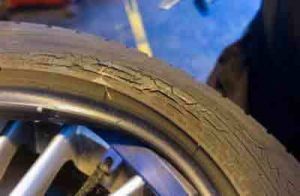
If your tires are gradually aging, you will notice cracks on the sidewall, also between the treads of your tires.
This is also one of the common signs that your vehicle needs a new tire and as a driver or user, you should take this sign seriously.
Having cracks is a sign that your tires are starting to break down, this occurs naturally due to exposure to sunlight, chemicals, and other components that reduce the flexibility of the tire over time.
As the flexibility declines, cracks will develop and once the cracks develop, the lifespan of the tire will come to an end in a short time.
You should know that more cracks will develop if you notice a crack on your sidewall and then you left it unaddressed or replaced, more wear and tear will continue leading to more cracks.
This will eventually lead to where the sidewall of the tire will split and breaks open, making the wheel and will lead to more damages to the vehicle.
When your vehicle constantly vibrates
Vehicle tires that are not in a good condition can also make your vehicle vibrate, yes! Indeed one of the most common reasons for your vehicle to shake is related to the tires.
When your tires are imbalanced, the steering wheel will start shaking when you drive simply because your vehicle tires are the only component of your vehicle that makes contact with the road. Your vehicle constantly vibrating is one sign your tires need to be replaced.
For you to avoid such a problem you have to get new tires, buy a good quality tire, and make sure you have all tires properly checked anytime you take your vehicle for preventative maintenance services.
Expired tires
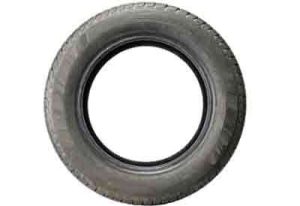
Most tires often come with a warranty guaranteeing them to last for a specific period. For most tires, the expiration date is six years from the manufacturing date.
When your tires have passed that expiration date, it is important to inspect them and have them replaced with a new set of tires immediately.
Tires weaken and fall apart as you use them daily, old tires are more likely to fail than new ones. And because they are made of rubber, they will degrade with time.
General wear and tear, heat, and sunlight can increase the breakdown of a tire. Expired/Old tires are hazardous, as they have been the culprit in fatal accidents. So you shouldn’t use your tires for too long, get them replaced after 6 years.
Driving a spare tire for a long time
“You can drive normally on your spare tires”, the neighbor next door advised you, and ever since you have been wondering whether to take them off or not because it’s been 3 days now you’ve been driving on them.
Well, you’ve thought it wrong. You should know your spare tires enables you to drive down to the nearest repairer’s shop to have your flat tires checked either replaced or repaired.
A spare tire is meant as a temporary solution. You should not drive over 50mph or more than 50 miles with them.
If you drive a long distance with your spare tires, it can lead to more damages to other components of your vehicle, including the transmission.
Spare tires are not as long-lasting as your regular tires, as it’s light and small, they provide less cornering ability, less traction and it’s not entirely meant for permanent use.
Kindly get those spare tires replaced with a new set of quality tires.
When your tire cords are visible
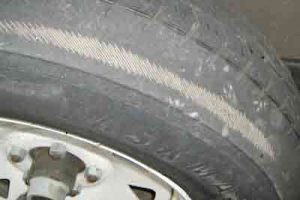
If a tire’s tread gradually wears down, the “Cords” or wires inside the inner liner will become visible. If the cords or wires are showing, it may be that there’s uneven wear due to poor alignment or that the tire is out of balance.
Regardless, when your tire cords are showing, your tire will perform properly and will become unsafe for driving, it is also likely to a blowout. You simply just have to get your tires replaced.
You can see the tread wear indicator bars
Most new tire brands have built-in tread wear indicator bars also known as “Tire wear bars” which are small raised bars that are between the grooves of your tire’s tread.
They are quite useful when it comes to inspecting how a tire performs regarding wear.
The tire tread will help you stabilize your vehicle in wet conditions, and also help provide better handling and traction.
You are likely to find yourself getting out of control without it, that is why it is recommended to keep an eye on your tire’s wear bars.
Just like the blue strip you find on your toothbrush, the tread wear indicator bars tell you when your tires need to be replaced.
The wear bar will become visible as the tread wears down. If your wear bars are at the same level as your tread then it’s time you need a new tire.
In a case where the tires are new, it will be difficult to see the wear bars because the threads will still be new. But as the tires become cold, the treads will wear off and gets thinner, when this happens the bars will become visible.
When the bars are starting to become visible, the tires will start to make an unpleasant sound. One way to check the performance of your tire tread is to horizontally run your finger over the tire wear bars.
If you feel that the wear bar against your fingers is at the same level as the tread, then it’s time to buy new tires.
When there is uneven wear on your tires
When tires are not properly inflated or have a poor alignment, it can unevenly make them wear out. A tire with uneven wear can also be one of the signs that your vehicle’s suspension is getting bad.
Underinflated tires wear out faster on the edge while over-inflated tires will wear out in the center.
Tires are an important part of your vehicle and it’s important to check them regularly to see how they are performing; with this, you can easily decide if you need a new tire.
Conclusively, the reasons for tires to wear unevenly boils down to two major factors; Improper tire inflation and Misalignment.
Improper tire inflation
When your tires are inflated to the correct pressures, there will be optimal weight as this will not only keep your tire’s treads safe but help in both turning and braking.
When the pressure is too high or low, the tire will work much stress as well. Do well to check your tire’s pressure regularly, especially when you notice your ride is becoming uncomfortable.
Go to your owner’s manual guide or get in touch with a mechanic expert to ensure you’re inflating right.
- Misalignment: Tire alignment is an important regular service that can make a difference in your vehicle’s systems. Misalignment is usually common due to hitting a curb or potholes, which can be dangerous to your vehicle over time. Fortunately, Misalignment can be easily fixed with the help of an expert.
Bulges on the tire
Tire bulges are a result of when you over-inflate your tires or hit debris on the road. You should replace a bulging tire immediately to stay safe on the road as the tires are one of the most key parts of your vehicle.
A flat, leaking, or bulging tire can be perhaps dangerous because it can lead to a blowout.
A bulging tire is a sign that the interior of the tire has failed and the tire requires immediate repair or replacement because if you hesitate to replace the tire, it can explode, making you or any user lose control and possibly lead to an accident.
If you notice there is an unusual with your tire, you may want to be sure what a bulge is and how a bulge can affect your driving:
- A tire bulge is likely caused by hazards such as hitting a curb or potholes, sometimes you may not see the bulge when it happens, but as soon as you see a tire bulge, kindly contact a mechanic so you can get your tires replaced.
- Underinflating or overloading are also common causes. If the vehicle carries a heavy load, it puts a lot of pressure. Additionally, underinflating the tire will not give it the support it needs to handle the vehicle. Ensure to take note of how much your vehicle can carry along with properly inflating the tires.
- A bulging tire allows air to get through the internal layers and gets to the outside of the tire.
- When a tire bulges, the cords on the interior of the vehicle become visible and can lead to the tire failing, since the tire has become weak, it can not handle debris on the road. You’ll have to replace your tire immediately you notice a bulge on your tire.
On rare occasions, a tire bulge can also be a result of a manufacturer defect, if this is the case, you should have your tire covered under a warranty, but know that a tire bulge cannot be repaired so you have to replace the whole tire by a mechanic.
When your tire pressure light comes in
Most vehicles have a TPMS (Tire pressure monitoring system) that tells you when your tires are too low and might create an unsafe driving condition.
If the light is bright, it means your tires are underinflated, this can lead to uneven tire wear and likely tire failure.
If you notice the signs come up a lot, it can be a sign that your tire is getting worn out. Whenever the sensor light comes on, you should double-check your tire pressure by having it checked manually.
This is a regular part of vehicle maintenance, but it is ideal to have your tires checked by an expert.
Expect these few signs that visibly present themselves to you. You’ll only know your tires are due to be replaced if you take time to inspect them regularly.
Every few weeks, take time out to inspect your vehicle and check for any of the signs discussed above. If you do see something, you should not hesitate to replace your tires, with this, you’ll be guaranteed to have a safe drive on the road.
Related topics:
- How Long Can You Ride On a Flat Motorcycle Tire
- Can a Plugged Tire Be Patched
- How Long Can You Drive on a Broken Tire Belt
- Can a Bike Tire Go Flat Without Holes

